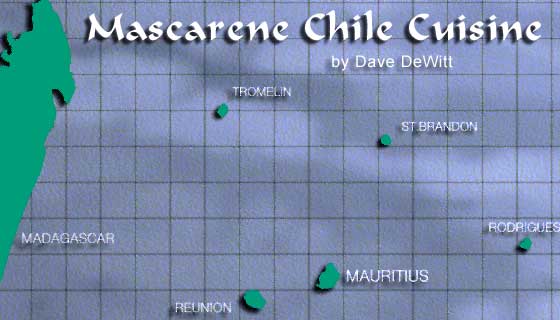|
Recipe Index Piment Limon Mascarene Chile Paste Sauce Rougaille Mauritian La Réunion Tiger Prawns Mascarene |
Did Portuguese explorer Pedro Mascarenhas bring chile pepper seeds to the three islands in the Indian Ocean he discovered in 1502? After all, it was nine years after Colombus brought chiles back from the Bahamas, and Portuguese explorers and traders were introducing them into Africa and India. The answer is: probably not–the date is just too early. The three islands of the Mascarene group–Réunion, Mauritius, and Rodrigues–weren’t settled until more than a hundred years later, and it wouldn’t make much sense to introduce chiles without someone to grow them. So if Mascarhenas does not receive the glory of introducing chiles, at least he had the honor of the islands being named after him.
But few people have ever heard of the Mascarenes, and the islands are more known by their individual names. They lie hundred of miles east of Madagascar, hundreds of miles away from each other, and although they vary greatly in geography, culture, and religion, they have one great thing in common: a love of chile peppers. On all three islands, chiles of every size and heat level are lovingly grown and added to a cuisines that can generically be called Creole.
 |
Mountains of Réunion
|
Réunion, about 500 miles east of Madagascar, is volcanic in origin and extremely mountainous, with peaks over ten thousand feet high. First settled in the mid-1600s by colonists from France, the island has depended on sugar cane and laborers imported from East Africa, Malays, Chinese, and Indians. In this respect, it is very similar to Trinidad in the eastern Caribbean. Today, the population of over one million is of mixed, Creole descent, and the island is a departement of France.
|
Sugar Cane Fields of Mauritius
|
 |
Mauritius, known as Maurice in French, lies east of Réunion and is also of volcanic origin. But its upper plateau rises only to about 2,400 feet and the island is surrounded by coral reefs. It was first settled by the Dutch in the mid-1600s but they abandoned the island and left it to pirates. In 1721, the French East India Company occupied Mauritius and ruled it for 40 years until the French government took over. Sugar cane was the main crop, and Africans and Indians were the principal laborers. Today it is an independent country and is known for its five-star hotels and sport fishing fleet.
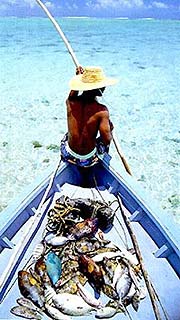 |
Rodriguan Fisherman
|
Rodrigues, 340 miles further east, is a dependency of Mauritius is also of volcanic origin, but has no mountains. It is the smallest of the three and has a population of less than 40,000. It survives on tourism, fishing, and subsistence farming, and like its two sisters has a Creole population. It is called “The Cinderella of the Mascarenes” and the natives grow a very hot chile (“the hottest in the world,” according to the vendors) called the Piment Rodrigues or Rodrigues Pepper.
For furher information on Mauritius and Rodrigues, visit www.mauritius.net
The Chiles
Here’s an interesting question: If Mascarhenas didn’t introduce chiles to these islands, who did? Pepper expert Jean Andrews credits Portuguese traders and spice merchants with introducing chiles into Mozambique and other parts of East Africa and Madagascar sometime in the mid-1500s. Once established there, they were probably imported into the Mascarenes along with the first African slaves in the 17th century.
The types of peppers grown in the Mascarenes vary from island to island and from farm to farm, but there is significant commercial cultivation. Statistics were hard to find, but one website reported that the production of “small peppers” on Réunion grew from 81 tons in 1981 to 405 tons in 1992. About one-fifth of the peppers available in Réunion are imported from Mauritius.
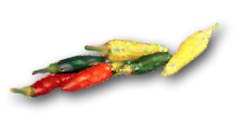 |
Piment Rodrigues
|
After searching through French language websites and translating them into English, I came up with the following commonly cultivated varieties in the Mascarenes, from smallest to largest:
-
CABRI, a small chile from Mauritius.
-
Rodrigues, about one inch long and crinkly, from Rodrigues.
-
Carri, a medium-sized chile that is often battered and fried.
-
Cipaye, the largest of the chiles grown in the Mascarenes.
The Hot and Spicy Cuisine
Considering the ethnic mix of the populations of these three islands, it is not surprising that the cuisine is very diverse. A native or visitor can start the day with a continental breakfast of coffee and a French croissant, eat Indian food for lunch, and dine on Chinese or Creole food for dinner. The influence of chiles is evident in the variety of hot sauces available, including the piment limon that is a trademark of Rodrigues; rougaille, a spiced-up French tomato sauce; chile pastes; and the Indian chutneys.
The sauces are sold by vendors in the market on Rodrigues. James Bowyer, writing about them in the South African magazine, Out There, noted: “Chiles are taken seriously on Rodrigues and the chile man is doing brisk business although brisk is a word that seems out of place on the laid-back island. His stall is crammed with dozens of recycled rum bottles filled with yellow, orange, and green luminous chiles and sauces. Each bottle is sealed with a screw-on cap, the rum labels have been drunk away and replaced with squarish hand-written ones: piment limon. Achard Limon, Limon Tamouric and so on.”
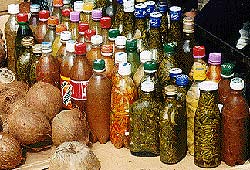 |
Chile Products in the Rodrigues Market
|
Indian curries of all kinds play a key role in the hot and spicy Mascarene cuisine. They are vegetarian, shrimp, fish, chicken, lamb, and beef–all heavily spiced with various chiles. In fact, chiles appear in many different dishes, including chile cakes, pickles, a chile jam called mazavaroo, chile prawns and crabs, and many fish dishes.
After I had completed my research on the fiery cuisine of the Mascarenes, I decided to prepare piment limon, a condiment that was raved about in an article in Condé Nast Traveler. I couldn’t find Rodrigues Pepper at my local Albertsons Supermarket, and my Indian chiles were not red yet, so I substituted red jalapeños and remembered the description of James Bowyer: “As the chile sauce store owner unscrewed the cap, a spicy aroma escaped the bottle like an angry genie.” The same aroma arose from my blender.
The Recipes
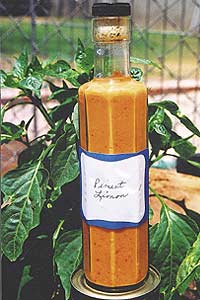 |
Piment Limon, DD Style
|
Here is my version of the classic hot sauce of Rodrigues Island. It is very thick, so feel free to thin with more water if you want. You’d think that this sauce might be sour, but it’s not–the sugar in the red chiles seems to temper it. Any fresh red chiles can be used, and you can adjust the heat level to your liking. The yield is high here, but the color is so beautiful that you should put the excess in decorative bottles as gifts for your friends. It will keep for several weeks in the refrigerator. Serve it over fish or other seafood.
-
6 cups water
-
10 lemons, thickly sliced, seeds removed (or substitute limes for a different color)
-
8 to 10 red jalapeños, seeds and stems removed, halved
-
1/4 cup vegetable oil
Place the water in a large pot and bring to a boil. Add the lemon slices and boil for 20 minutes. Strain, reserving the water.
Place the jalapeños in a blender and add the oil. Puree to make a thick paste. Add the lemon slices, a few at a time, along with 3 cups of the reserved water, a half cup at a time. You may have to do this in batches in you don’t have a large blender. Puree to a thick sauce. Pour into bottles and label.
Yield: 6 cups
Heat Scale: Hot
This recipe probably has an Indian origin because of the use of ginger. It can be thinned to make a sauce or added directly to seafood or grilled meat dishes. It can also be served over rice or potatoes. For a milder paste substitute 5 fresh red New Mexican chiles–but don’t roast and peel them. The paste will keep in the refrigerator for a couple of weeks.
-
15 red jalapeños, seeds and stems removed, quartered
-
2 medium onions, peeled and quartered
-
2 tablespoons grated ginger
-
1 tablespoon vinegar
-
1/4 cup vegetable oil
Add the jalapeños, onions, and ginger to a blender or food processor and process to a smooth paste, adding a little water if necessary. Transfer to a bowl and mix in the vinegar.
Add the oil to a saucepan and heat until quite hot and stir in the paste, mixing well. Reduce the heat and simmer until the paste thickens. Take care that the paste does not burn. Simmer for about 10 minutes. Remove, cool, and store in clean jars.
Yield: About 3 cups
Heat Scale: Hot
This classic French tomato sauce is typically spiced up in the Mascarenes with the addition of of the Carri chiles. Use New Mexican chiles as a substitute but there’s no need to roast and peel them since they are chopped so finely. It is served over salted fish (salt cod), but works fine with fried or grilled fish, shrimp, chicken, rice, or pasta. For a hotter sauce, substitute jalapeños.
-
1/4 cup vegetable oil
-
4 New Mexican chiles, seeds and stems removed, finely chopped
-
2 teaspoons grated ginger
-
2 teaspoons minced garlic
-
2 medium onions, peeled and finely chopped
-
1 tablespoon tomato paste
-
2 large tomatoes, peeled and choppped
-
1 tablespoon chopped fresh thyme
-
2 tablespoons chopped fresh parsley
-
Salt and pepper to taste
Pour the oil into a wok or large saute pan and heat until hot. Add the chiles, ginger, garlic and onion and saute until the onions are soft, about 10 minutes, stirring constantly. Add the tomato paste and cook for 30 seconds, stirring constantly. Add the tomatoes, stir, cover, and simmer on medium heat for 10 minutes. Remove from the heat and check for consistency, adding some water if too thick. Stir in the thyme and parsley, adjust the salt and pepper, and serve.
Yield: About 3 cups
Heat Scale: Mild
Chutneys, originally from India, are now worldwide and are made from an astounding number of different ingredients such as apples, raisins, mangoes, bananas, and even prunes! It makes sense that people of Indian descent living in tropical climates would use the ubiquitous coconut. Add any fruits you like to this chutney and use it to accompany the chicken curry recipe in this article. The chutney will keep for 3 or 4 days in the refrigerator, or can be frozen.
-
2 tablespoons vegetable oil
-
2 cups grated coconut
-
1 lemon, quartered
-
2 teaspoons tamarind paste (available at Asian markets)
-
5 small green chiles, such as serrano, or substitute 3 jalapeños
-
2 cloves garlic
-
2 tablespoons mint leaves
-
Water as needed
Pour the vegetable oil into a frying pan and heat it. Add the coconut and saute until the coconut is golden brown. Remove from the heat and transfer to a blender or food processor. Add the remaining ingredients and process to a fine paste, adding water as needed. Serve at room temperature.
Yield: About 2 ½ cups
Heat Scale: Medium
Here’s the familiar-sounding chicken curry with a couple of twists from the island of Réunion. Of course, serve it with rice and accompanied by the coconut curry in this article. Make your own curry powder, or buy an imported powder from India for the best results because American curry powders are inferior.
-
1/8 pound butter (½ cup)
-
3 tablespoons vegetable oil
-
1 chicken, cut up into serving pieces
-
2 onions, peeled and chopped
-
1 clove garlic, chopped
-
2 large tomatoes, peeled and chopped
-
1 tablespoon grated ginger
-
3 tablespoons curry powder
-
2 teaspoons cayenne powder
-
1 pinch saffron
-
1 eggplant, peeled and diced
-
1 large potato, peeled and diced
-
Water as needed
-
Salt and pepper to taste
Combine the butter and oil in a large frying pan or Dutch oven and heat. Add the chicken and fry over medium heat for fifteen minutes until golden brown, turning occasionally.. Remove the chicken and reserve. Add the onion and garlic and fry until the onions are soft, about 5 minutes. Add the tomatoes and cook for 5 minutes. Add the ginger, curry powder, cayenne, and saffron and cook for 2 minutes, stirring occasionally. Add the reserved chicken, eggplant, and potato, cover, and cook for about 20 minutes over medium heat or until the chicken and potatoes are tender. Add water if the mixture gets too thick. Adjust the salt and pepper and serve.
Yield: 6 servings
Heat Scale: Medium
It’s up to you to decide how hot you want these prawns, but we’ll give our recommendation for hot ones. Chile powder can be substituted for the fresh chiles if they are not available, but the consistency of the sauce will be slightly different. Serve this with rice pilaf and a fruit salad.
-
3/4 cup plus one tablespoon cornstarch
-
2 egg whites
-
2 teaspoons salt
-
1 tablespoon dry sherry (or more if needed)
-
1 pound prawns or large shrimp, peeled and deveined
-
1 ½ cups vegetable oil
-
1 teaspoon sesame oil
-
1 medium onion, peeled and sliced
-
1 tablespoon tomato paste
-
Pinch of white pepper
-
1 teaspoon sugar
-
2 green onions, finely chopped
-
1 teaspoon grated ginger
-
4 jalapeños (red preferred), seeds and stems removed, minced
-
1 tablespoon chicken stock
In a bowl, combine the 3/4 cup cornstarch, egg whites, 1 teaspoon salt, and the dry sherry and mix well to make a batter. Add the prawns to the batter and coat well.
Heat the vegetable oil in a wok until hot. Add the coated prawns and stir fry for 2 minutes. Do not overcook. Remove the prawns and drain them on paper towels.
Remove all but about 1 tablespoon of oil from the wok. Add the sesame oil. Reheat the wok and stir-fry the onion slices for 1 minute. Add the tomato paste, white pepper, remaining salt, and sugar. Add the reserved prawns, green onions, ginger, and jalapeños and stir fry for 1 minute.
In a small bowl, combine the 1 tablespoon of cornstarch with the chicken stock and add to the wok to thicken the sauce. Serve immediately.
Yield: 4 servings
Heat Scale: Hot
Okay, this is my name for this recipe because it sounds better than “Chile Balls.” The dal used here is the common Indian ingredient dried split peas, available in Asian markets. The key to keeping the hush puppies from falling apart is to grind at least half of the soaked peas to a very fine consistency. Serve as an accompaniment to the other recipes in this article, or as a snack. Note: This recipe requires advance preparation.
-
2 cups dal (dried split peas)
-
2 red or green jalapeños, seeds and stems removed, minced
-
2 tablespoons chopped cilantro
-
2 tablespoons finely chopped green onions
-
½ teaspoon powdered cumin
-
Vegetable oil for frying
Wash the dal in a colander, then place it in a bowl and cover with three times as much volume of water. Allow to soak for at least 4 hours and preferably overnight. Drain the dal and place half of it in a blend and process to a fine consistency. Remove from the blender with a spatula and place in a bowl. Place the remaining dal in a blender and process to a medium consistency. Remove to the same bowl. Add the remaining ingredients except the oil and mix well
Form the mixture into balls about 1 ½ inches in diameter.
Heat the oil in a pan until hot and deep fry the balls until they are golden brown. Remove and place on paper towels to drain. Serve them hot
Yield: 6 to 8 servings
Heat Scale: Medium

